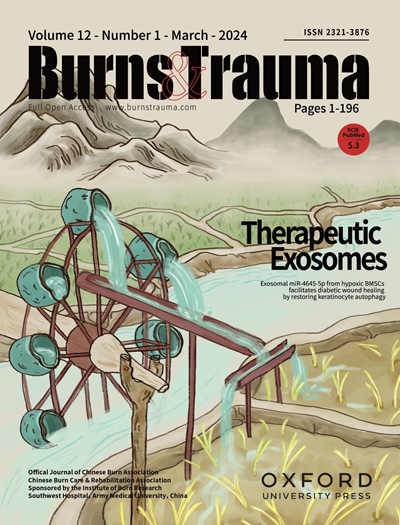Innovations in hydrogel therapies for diabetic wound healing: bridging the gap between pathophysiology and clinical application
IF 9.6
1区 医学
Q1 DERMATOLOGY
引用次数: 0
Abstract
Diabetic wounds (DWs), which are complex and challenging to treat due to delayed healing and incomplete regeneration, pose a significant burden on global healthcare systems. Existing clinical interventions, which mainly comprise debridement, decompression, and wound dressings, have limited efficacy. In addition, DW pathogenesis is complex, with diabetic peripheral neuropathy (DPN), diabetic peripheral arterial disease (PAD), and diabetic foot infections (DWIs) further complicating wound management. Owing to their unique versatility, tunability, and hydrophilicity, hydrogels show promise in several biomedical applications, including DW management. They can effectively promote DW healing by loading therapeutic substances for on-demand release. Given the distinct physiological milieu of DWs, hydrogels with tailored attributes can be engineered to enable on-demand drug release, optimize the wound microenvironment, and cater to the diverse stages of wound healing. Based on the clinical status and pathophysiological features of DWs, this review explores hydrogel wound dressings with the following effects: hypoglycemic, nerve regeneration, vascular regeneration, anti-infective, and bone repair. Additionally, the strategy for applying hydrogels to DWs has been comprehensively studied to provide a robust theoretical foundation for DW treatment and pave the way for clinical translation.水凝胶治疗糖尿病伤口愈合的创新:弥合病理生理学和临床应用之间的差距
糖尿病性伤口(DWs)由于愈合延迟和再生不完全,治疗复杂且具有挑战性,给全球卫生保健系统带来了重大负担。现有的临床干预措施主要包括清创、减压和伤口敷料,但效果有限。此外,DW的发病机制很复杂,糖尿病周围神经病变(DPN)、糖尿病周围动脉疾病(PAD)和糖尿病足感染(dwi)进一步使伤口管理复杂化。由于其独特的通用性、可调节性和亲水性,水凝胶在包括DW管理在内的多种生物医学应用中显示出前景。它们可以通过装载治疗物质按需释放有效促进DW愈合。考虑到DWs独特的生理环境,可以设计具有定制属性的水凝胶,以实现按需释放药物,优化伤口微环境,并满足伤口愈合的不同阶段。本文结合DWs的临床现状和病理生理特点,探讨了水凝胶创面敷料在降血糖、神经再生、血管再生、抗感染、骨修复等方面的作用。此外,对水凝胶应用于DW的策略进行了全面的研究,为DW的治疗提供了坚实的理论基础,为临床翻译铺平了道路。
本文章由计算机程序翻译,如有差异,请以英文原文为准。
求助全文
约1分钟内获得全文
求助全文
来源期刊

Burns & Trauma
医学-皮肤病学
CiteScore
8.40
自引率
9.40%
发文量
186
审稿时长
6 weeks
期刊介绍:
The first open access journal in the field of burns and trauma injury in the Asia-Pacific region, Burns & Trauma publishes the latest developments in basic, clinical and translational research in the field. With a special focus on prevention, clinical treatment and basic research, the journal welcomes submissions in various aspects of biomaterials, tissue engineering, stem cells, critical care, immunobiology, skin transplantation, and the prevention and regeneration of burns and trauma injuries. With an expert Editorial Board and a team of dedicated scientific editors, the journal enjoys a large readership and is supported by Southwest Hospital, which covers authors'' article processing charges.
 求助内容:
求助内容: 应助结果提醒方式:
应助结果提醒方式:


